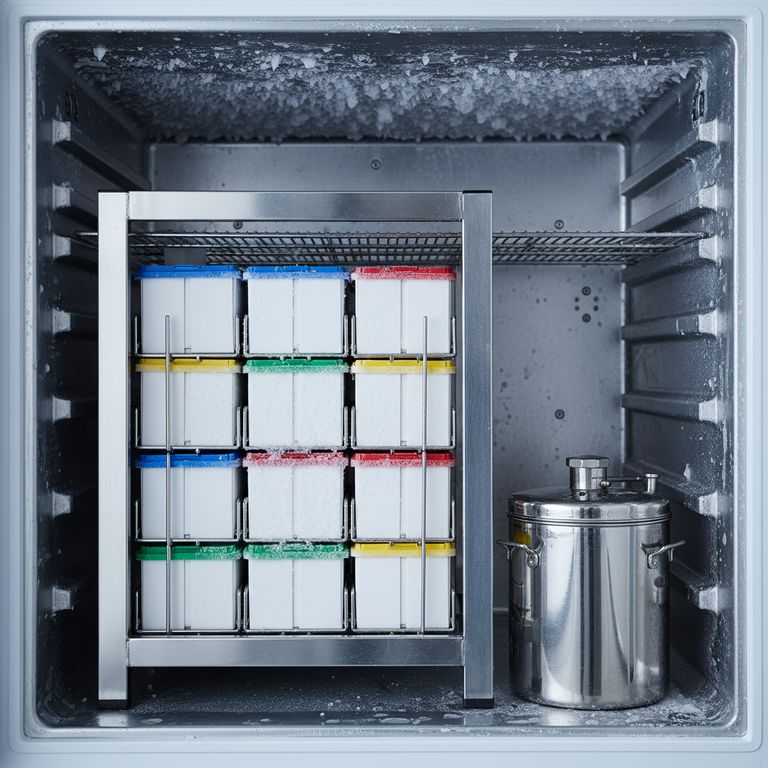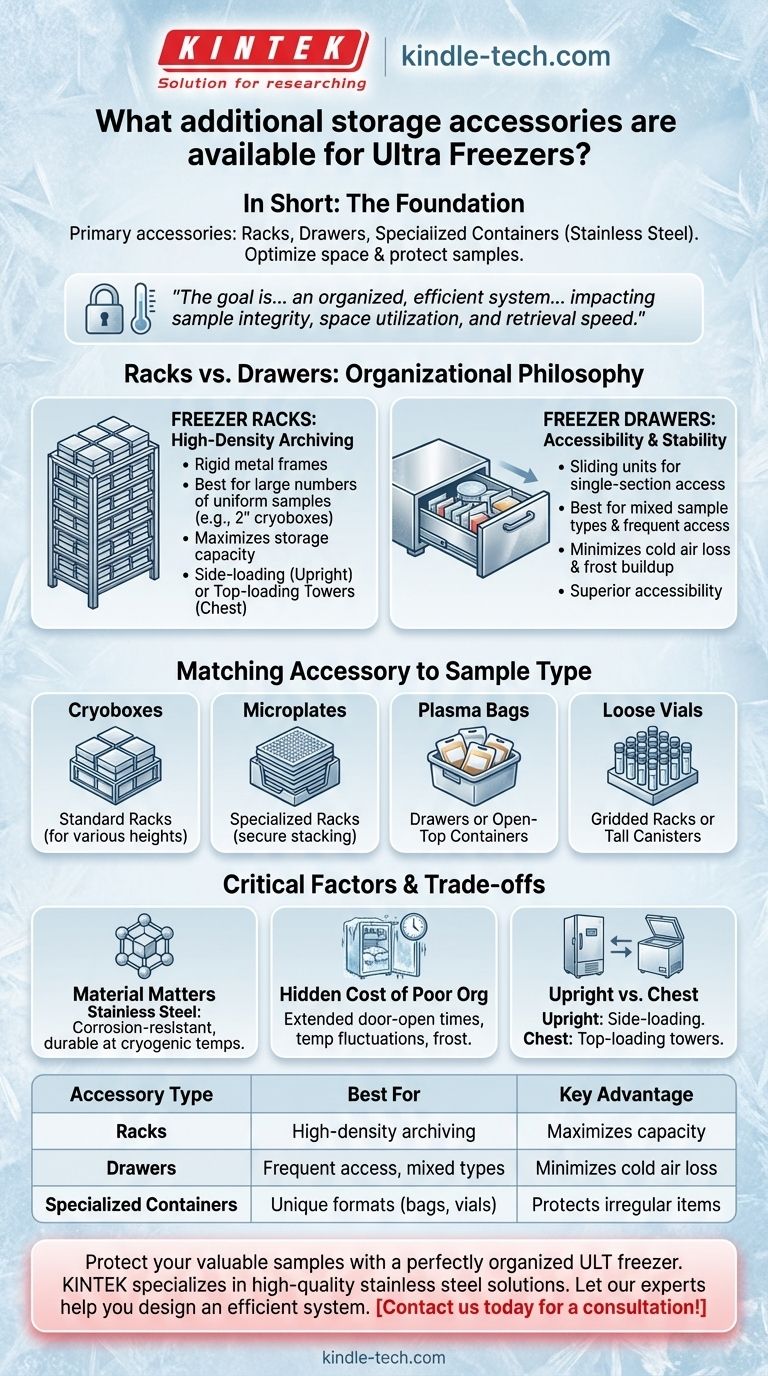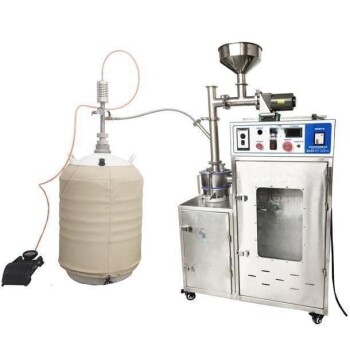In short, the primary storage accessories for ultra-low temperature (ULT) freezers are racks, drawers, and specialized containers. These are typically made of stainless steel and are designed to hold common laboratory consumables such as cryoboxes, microplates, blood plasma bags, and test tubes, optimizing space and protecting samples.
The goal is not simply to fill the freezer, but to create an organized, efficient system. The right accessory depends entirely on your sample format and your lab's workflow, directly impacting sample integrity, space utilization, and retrieval speed.

The Foundation of Freezer Organization: Racks vs. Drawers
The most fundamental choice you will make is between a rack-based system and a drawer-based system. Each serves a different organizational philosophy.
Freezer Racks: The Standard for High-Density Storage
Freezer racks are rigid metal frames with shelves designed to hold boxes or plates. They are the most common solution for maximizing storage capacity.
They are ideal for archiving large numbers of uniform samples, such as standard 2-inch cryoboxes, that are not accessed frequently. Racks for upright freezers load from the side, while racks for chest freezers are towers that load from the top.
Freezer Drawers: Prioritizing Accessibility and Stability
Freezer drawers are sliding units that allow you to pull out a single section at a time. This is their key advantage over racks.
By opening only one drawer, you minimize cold air loss from the main freezer compartment, which reduces temperature fluctuations and frost buildup. Drawers are superior for storing mixed sample types or items that your team needs to access often.
Matching the Accessory to the Sample Type
While racks and drawers form the basic structure, their internal configuration must match what you intend to store.
For Cryoboxes
Most ULT freezer organization is built around the standard footprint of a cardboard, plastic, or metal cryobox. Racks are the default, specified by the number of boxes they hold and the height of each box (e.g., 2-inch or 3-inch).
For Microplates and Deep-Well Plates
Microplates have a unique size and cannot be stored efficiently in standard cryobox racks. Specialized racks are available that hold plates securely in stacks, maximizing density.
For Blood Plasma Bags or Boxes
Plasma bags or the cartons they are shipped in are often irregularly shaped. Trying to force them into standard cryobox racks wastes space and can damage the bags. Drawers or larger, open-top steel containers are often a better solution for this format.
For Loose Vials or Test Tubes
While most tubes are stored within cryoboxes using dividers, some applications require storing them directly. Specialized racks with gridded holes or tall canisters are designed for this purpose, preventing tubes from tipping over.
Understanding the Trade-offs and Critical Factors
Choosing an accessory is a long-term decision that impacts your lab's efficiency and the security of your samples.
Material Matters: Stainless Steel
The vast majority of high-quality ULT freezer accessories are made from corrosion-resistant stainless steel. It is durable, easy to clean, and can withstand cryogenic temperatures without becoming brittle. It provides the longevity required for long-term sample storage.
The Hidden Cost of Poor Organization
An unorganized freezer is more than an inconvenience. It leads to extended door-open times as researchers hunt for samples, causing significant temperature fluctuations that can compromise sample integrity. It also accelerates frost buildup, which degrades freezer performance and requires more frequent defrosting.
Upright vs. Chest Freezer Configurations
Your freezer's orientation dictates the type of accessory you need. Upright freezers use side-loading racks and drawers. Chest freezers require vertical towers or canisters that can be lifted out from the top. They are not interchangeable.
Making the Right Choice for Your Goal
Select your storage system based on your primary operational need.
- If your primary focus is long-term archiving of uniform samples: Choose standard stainless steel racks designed for your box size to achieve the highest possible storage density.
- If your primary focus is frequent access to diverse sample types: Choose a drawer-based system to improve accessibility and minimize temperature fluctuations during retrieval.
- If your primary focus is storing microplates or other specialized formats: Invest in racks specifically designed for that item to ensure a secure fit and efficient use of space.
Ultimately, a well-planned storage system is your first line of defense in protecting the value and integrity of your critical samples.
Summary Table:
| Accessory Type | Best For | Key Advantage |
|---|---|---|
| Racks | High-density archiving (e.g., cryoboxes) | Maximizes storage capacity for uniform samples |
| Drawers | Frequent access, mixed sample types | Minimizes cold air loss, improves accessibility |
| Specialized Containers | Unique formats (e.g., plasma bags, loose vials) | Protects irregularly shaped items, prevents spills |
Protect your valuable samples with a perfectly organized ULT freezer. The right storage accessories are critical for maintaining sample integrity, improving retrieval speed, and maximizing your investment. KINTEK specializes in lab equipment and consumables, serving laboratory needs with high-quality, corrosion-resistant stainless steel racks, drawers, and containers designed for ultra-low temperatures.
Let our experts help you design an efficient storage system tailored to your specific samples and workflow. Contact us today for a personalized consultation to enhance your lab's cold storage capabilities!
Visual Guide

Related Products
- 58L Precision Laboratory Ultra Low Temperature Upright Freezer for Critical Sample Storage
- 408L Advanced Vertical Laboratory Ultra Low Temperature Freezer for Critical Research Material Preservation
- 708L Ultra Low Temperature Freezer High Performance Laboratory Freezer
- 208L Advanced Precision Laboratory Ultra Low Temperature Freezer for Cold Storage
- 608L Essential Laboratory Ultra Low Temperature Freezer For Critical Sample Preservation
People Also Ask
- What are the key construction features of ultra low temperature freezers? Essential Design for Protecting Critical Samples
- What factors should be considered when selecting an ultra-low temperature freezer? Ensure Sample Integrity and Long-Term Value
- How do Ultra-Low Temperature freezers ensure the integrity of microbiological samples? Maintain Stability for Critical Research
- What are the common designs of ultra-low temperature freezers? Upright vs. Chest Models for Your Lab
- What is ultra-low temperature freezing and what is its primary purpose? Preserve Biological Samples for Years
















